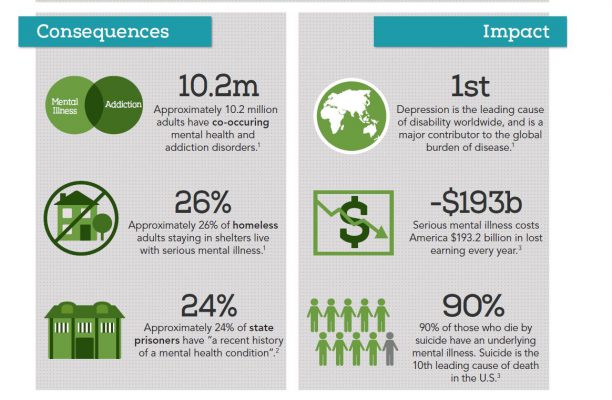Mental Health Awareness

May is Mental Health Awareness Month and it presents us with an opportunity to reflect on our own mental health and help erase the stigma of mental illnesses. Mental health is defined as realizing your abilities, coping with the normal stresses of life, working productively and contributing to society. You are not alone if you experience times when day-to-day stressors effect your coping mechanisms and require you to reach out for help from family, friends or professionals. Mental illness is real, and often requires treatment in order to improve.
Mental health and physical health are connected, making it important for primary care providers and behavioral health providers to maintain an open exchange of information, so both can see the full picture of an individual’s health and offer appropriate treatment. Please see the following for more information regarding mental health indicators: https://www.cdc.gov/mentalhealth/basics.htm.
Two common mental disorders are attention-deficit/hyperactivity disorder (ADHD) and depression. Although we think of ADHD as a childhood disorder and depression as an adult disorder, they both may affect individuals at various stages of life.

Infographics provided by NAMI (National Alliance of Mental Illness)
Depression
Depression is a serious mood disorder that affects how you feel, think, and handle daily activities, and usually requires treatment. Depression often begins in the teens, early 20s or 30s, but can occur at any age.
There are different types of depression, some persistent (lasting 2 years or more), and others situational (associated with major life changes, trauma or stress).
Signs and symptoms
You may be suffering from depression if you have been experiencing these or other symptoms for more than 2 weeks:
- sad or anxious
- feelings of hopelessness
- feelings of guilt or worthlessness
- loss of interest in activities
- decreased energy
- difficulty concentrating or making decisions
- difficulty sleeping or oversleeping
- appetite and/or weight changes
- thoughts of death or suicide
- restlessness, irritability
- persistent physical symptoms
Treatment
The earlier treatment begins, the more effective it is. Depression is usually treated with counseling, medication, or a combination of the two. Examples of evidence-based counseling approaches used for depression include cognitive-behavioral therapy, interpersonal therapy, and problem-solving therapy. If medications are prescribed, it is important to follow instructions carefully. It can take a while before improvement is seen, so don’t become discouraged. However, speak with your doctor if you’re not seeing the expected results so together you can determine whether a change in your treatment plan is needed. Learn more about psychotherapy and medications.
To Improve treatment you can –
- remain active/exercise
- set realistic goals
- spend time with others and confide in someone you trust
- expect gradual improvement, not immediate
- postpone important decisions until you feel better.
Learn more about improving outcomes
Attention-deficit/hyperactivity disorder (ADHD)
ADHD is usually diagnosed in childhood but often lasts into adulthood. Although most children may have difficulty paying attention and misbehave at times, for a child with ADHD these problems are often persistent and cause difficulty at school and at home.
A child with ADHD might persistently:
- Daydream
- Forget or lose things
- Squirm or fidget excessively
- Take unnecessary risks
- Have trouble taking turns or getting along with others
Potential risk factors include:
- Genetics
- Brain injury
- Exposure to harmful substances such as lead
- Alcohol and tobacco use during pregnancy
- Premature delivery or low birth weight
Although they may worsen symptoms, research does not show eating too much sugar, watching too much television, poverty or family chaos to cause ADHD.
Treatment
ADHD may be treated with behavior therapy, medication, or a combination of the two.
Behavior therapy is an important first step for young children because:
- Behavior therapy gives parents the skills and strategies to help their child.
- Behavior therapy has been shown to work as well as medication for ADHD in young children.
- Young children have more side effects from ADHD medications than older children.
- The long-term effects of ADHD medications on young children have not been well-studied.
Adults with ADHD
ADHD often lasts into adulthood and may be associated with depression, mood disorders and substance abuse. It may result in inconsistent performance at work, relationship problems, and chronic feelings of frustration and guilt.





Discussion
There are no discussions happening yet.